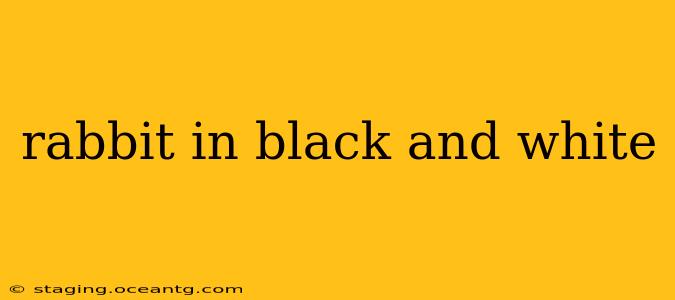The stark beauty of a rabbit depicted in black and white photography offers a unique aesthetic experience. Stripped of color, the focus shifts to form, texture, and light, revealing a depth often overlooked in full-color images. This monochromatic representation allows us to appreciate the subtleties of the rabbit's fur, the delicate structure of its ears, and the expressive power of its eyes. From the playful energy of a young bunny to the serene stillness of an older one, the black and white medium allows for a variety of artistic interpretations and emotional responses. This exploration delves into the captivating world of black and white rabbit photography, uncovering the reasons behind its enduring appeal.
Why Choose Black and White for Rabbit Photography?
The decision to shoot a rabbit in black and white isn't arbitrary; it's a deliberate choice that enhances specific aspects of the subject. The absence of color allows for:
-
Emphasis on Texture and Form: The variations in tone and shadow bring out the texture of the rabbit's fur, highlighting its softness or the coarseness of its whiskers. The form of the animal becomes more pronounced, revealing the delicate curves of its body and the elegant line of its spine.
-
Enhanced Contrast and Mood: Black and white photography is masterfully adept at creating dramatic contrasts. The interplay of light and shadow can evoke a wide range of moods, from playful energy to quiet contemplation. A starkly lit image can convey strength and resilience, while softer lighting can create a sense of peace and tranquility.
-
Timeless Aesthetic: Black and white photography transcends trends. It possesses a classic, timeless quality that endures across generations. Images of rabbits rendered in this style often convey a sense of nostalgia and simplicity.
-
Focus on Composition and Light: Without the distraction of color, the photographer's skill in composition and lighting becomes even more critical. The successful black and white image relies on carefully considered elements like light direction, shadow placement, and the overall arrangement of the subject within the frame.
What Makes a Great Black and White Rabbit Photograph?
A truly compelling black and white image of a rabbit goes beyond simply removing color. Several elements contribute to its success:
-
Strong Contrast: The interplay of light and dark is crucial. Well-defined shadows and highlights create depth and visual interest.
-
Sharp Focus: A crisp, sharply focused image showcases the details of the rabbit's fur, eyes, and features.
-
Interesting Composition: A well-composed image guides the viewer's eye through the scene, creating a sense of balance and harmony. Consider the rule of thirds and other compositional guidelines.
-
Emotional Impact: The best images evoke an emotional response in the viewer. This could be a sense of wonder, peace, or even a touch of melancholy.
How to Achieve the Best Black and White Rabbit Photos?
Achieving a successful black and white rabbit photograph requires careful planning and execution:
-
Lighting: Pay close attention to the lighting conditions. Natural light can be ideal, especially soft, diffused light. Experiment with backlighting, side lighting, and front lighting to achieve different effects.
-
Post-Processing: Post-processing is crucial for optimizing contrast, adjusting tones, and creating the desired mood. Software like Adobe Lightroom or Photoshop offers tools for enhancing black and white images.
-
Camera Settings: Utilize manual camera settings to control aperture, shutter speed, and ISO for optimal image quality.
-
Subject Interaction: Consider the rabbit's pose and behavior. Capturing natural, candid moments can result in more engaging and authentic images.
What equipment is needed for black and white rabbit photography?
While you can achieve excellent black and white photos with a variety of cameras, a DSLR or mirrorless camera with manual settings provides the greatest control over exposure and other settings. A macro lens is beneficial for close-up shots capturing intricate details, while a telephoto lens helps capture distant shots without disturbing the subject. Ultimately, the best equipment is the one you're most comfortable using and can consistently produce high-quality images.
Can I convert a color photo of a rabbit to black and white?
Absolutely! Many photo editing software programs allow you to easily convert color photos to black and white. However, the results will often look best if you shoot in RAW format, which preserves more image data for adjustments during post-processing. You can also experiment with different black and white conversion techniques in your editing software to achieve unique looks.
Where can I find black and white rabbit photos for inspiration?
Numerous online platforms, such as Flickr, 500px, and Instagram, showcase stunning black and white animal photography. Searching for "black and white rabbit photography" or similar terms will yield a wealth of inspiration. Consider looking at the work of professional wildlife photographers for advanced techniques and creative ideas. Exploring art galleries and photography books featuring wildlife or animal portraiture can also expand your creative vision.
This exploration of black and white rabbit photography showcases the power of simplicity and contrast. By focusing on form, texture, and light, we unlock a different dimension of beauty, revealing the unique charm and captivating spirit of the rabbit.
